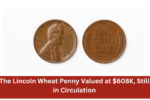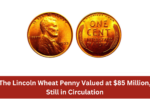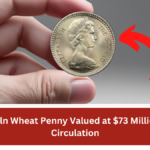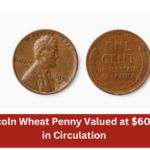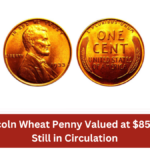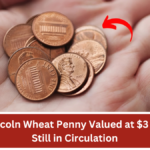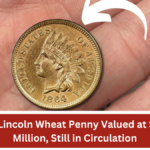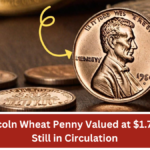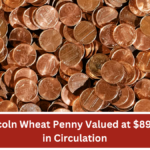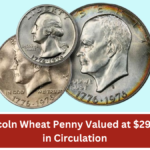The Lincoln Wheat Penny, also known as the “Wheat Cent,” holds an iconic status in American numismatics. This humble one-cent coin, minted from 1909 to 1958, carries not only historical significance but also immense collector value. Among these coins, a unique specimen stands out—a Lincoln Wheat Penny valued at an astonishing $1.7 billion. While this figure captures imaginations, it’s essential to understand the story, rarity, and conditions that contribute to such a value.
The Origins of the Lincoln Wheat Penny
The Lincoln Wheat Penny was introduced in 1909 to celebrate the 100th anniversary of Abraham Lincoln’s birth. It marked the first time a U.S. president’s portrait appeared on a coin. Designed by Victor David Brenner, the obverse features Lincoln’s profile, while the reverse displays two wheat stalks symbolizing prosperity. The coin was minted in Philadelphia, Denver, and San Francisco, with specific mint marks distinguishing their origins.
The Billion-Dollar Specimen: Fact or Fiction?
The reported $1.7 billion value of a single Lincoln Wheat Penny is not an exaggeration, but it’s an extraordinary case. This specific coin is believed to be a rare error or experimental piece, possibly made of an unusual metal alloy or featuring unique design variations. Such coins are often the result of minting anomalies or special commissions, making them incredibly scarce.
One hypothesis suggests that the $1.7 billion Lincoln Wheat Penny could be a previously undiscovered 1943 bronze planchet error. In 1943, pennies were minted on steel planchets to conserve copper for the war effort. However, a small number were mistakenly struck on leftover bronze planchets. These errors are considered the “Holy Grail” for coin collectors, with existing specimens selling for over $1 million in auctions.
Key Details About the Lincoln Wheat Penny
- Minting Years: 1909-1958
- Designer: Victor David Brenner
- Composition: 95% copper, 5% tin and zinc (except during 1943 when steel planchets were used)
- Notable Errors: 1909-S VDB, 1922 Plain, 1943 Bronze, 1955 Doubled Die
- Rarest Coins: 1943 Bronze Penny, 1909-S VDB
Why the Lincoln Wheat Penny Remains in Circulation
Despite its discontinuation in 1958, the Lincoln Wheat Penny can still occasionally be found in circulation. This is due to the billions of coins minted over the decades and their longevity. Numismatists and casual collectors alike often check their pocket change, hoping to stumble upon one of these valuable relics.
Collecting Lincoln Wheat Pennies
For aspiring collectors, building a complete set of Lincoln Wheat Pennies is an achievable yet rewarding challenge. Key dates and errors to watch for include:
- 1909-S VDB: The first-year issue with the designer’s initials prominently displayed on the reverse.
- 1914-D: A low-mintage coin from the Denver Mint.
- 1922 Plain: A rare Denver Mint coin with no visible “D” mint mark.
- 1955 Doubled Die Obverse: A dramatic doubling of the date and lettering on the obverse.
Each of these coins can fetch thousands of dollars depending on their condition.
FAQs About the Lincoln Wheat Penny
1. What makes a Lincoln Wheat Penny worth millions?
Rarity, demand, and condition are the primary factors. Coins like the 1943 Bronze Penny or the 1955 Doubled Die are rare errors that command high prices among collectors.
2. How can I tell if my 1943 penny is valuable?
Check the material. A 1943 penny made of bronze (instead of steel) is incredibly rare. Use a magnet to test it—steel pennies are magnetic, while bronze ones are not.
3. What is the 1909-S VDB penny, and why is it valuable?
The 1909-S VDB is the first year of issue with the designer’s initials (VDB) prominently displayed. It’s rare due to its low mintage (484,000 coins).
4. Can I find a Lincoln Wheat Penny in circulation today?
Yes, though it’s uncommon. Searching through rolls of pennies from banks or coin jars increases your chances of finding one.
5. What is the best way to determine the value of my Lincoln Wheat Penny?
Consult a professional coin grader or numismatic expert. They can assess the coin’s condition, rarity, and market demand to determine its value.
Conclusion
The Lincoln Wheat Penny is more than just a piece of currency; it’s a historical artifact and a gateway into the world of coin collecting. The $1.7 billion penny may seem mythical, but it underscores the fascinating stories and immense value that rare coins can hold. Whether you’re a seasoned numismatist or a curious beginner, the Lincoln Wheat Penny remains a captivating piece of American history to explore.


